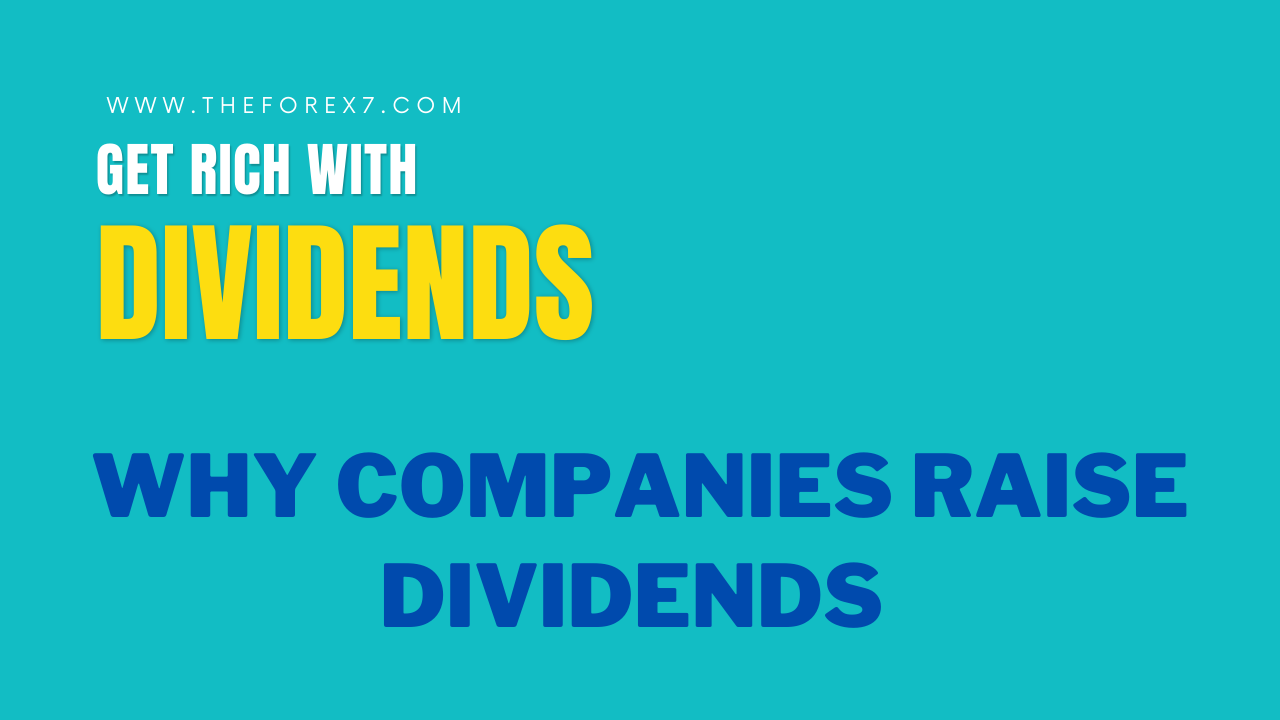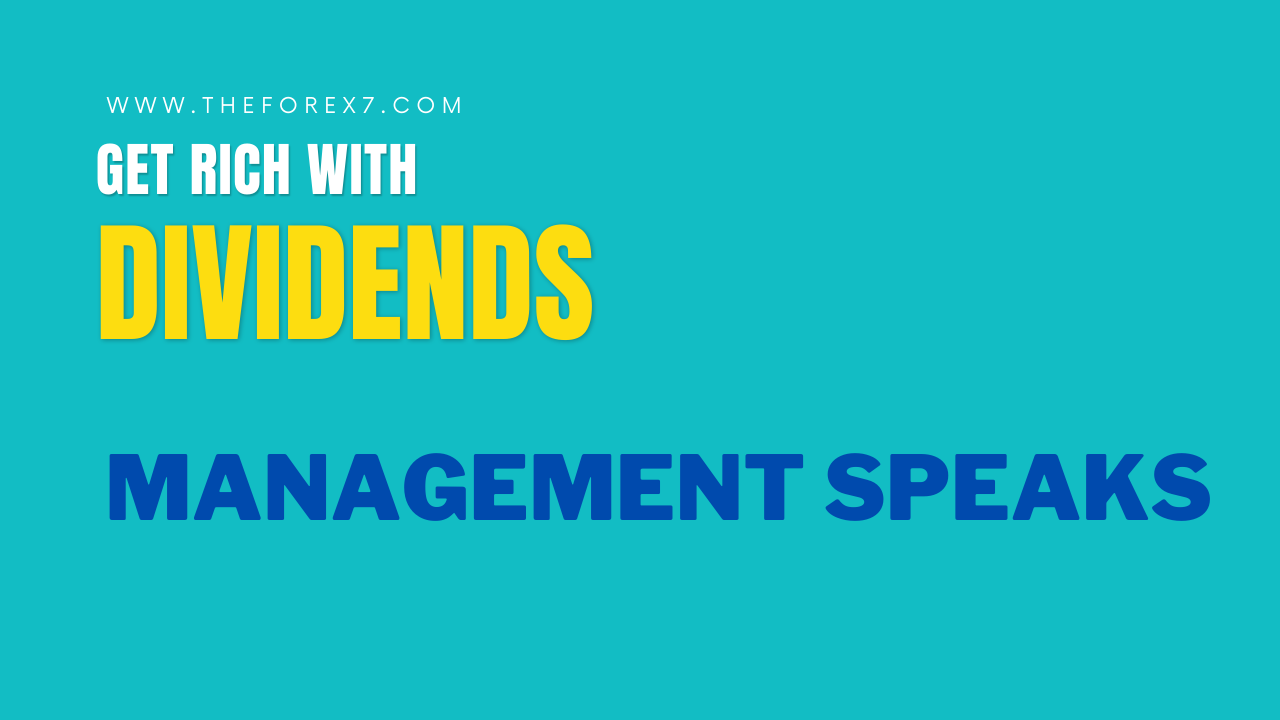Why Companies Raise Dividends
Why Companies raise dividends , Need of dividends in companies
Course: [ GET RICH WITH DIVIDENDS : Chapter 4: Why Companies Raise Dividends ]

Management wants to keep it to use for acquisitions, growing the company, and as a buffer against bad times. Unless a company is in its early stages or in hypergrowth mode, investors usually want to get some of that cash back particularly if the company is growing the amount of cash flow it brings in every year.
WHY COMPANIES RAISE DIVIDENDS
Generally speaking, management and investors have a difference of
opinion on what to do with the cash on the company’s balance sheet.
Management wants to keep it to use for
acquisitions, growing the company, and as a buffer against bad times. Unless a
company is in its early stages or in hypergrowth mode, investors usually want
to get some of that cash back—particularly if the company is growing the amount
of cash flow it brings in every year.
Going back to Marc Lichtenfeld’s
Authentic Italian Trattoria example, if you invested in my restaurant and after
a few years, we’re pulling in $200,000 per year in profit, you may start to get
antsy and demand some kind of payout.
I, however, may have my sights set on a
new location, or want to knock down a wall to expand seating, or add more staff
that will help turn the tables over more quickly.
At some point, I have to balance my
investors’ demands with my plans for growth. Of course, if you have more money
than you know what to do with, it’s an easier problem to solve.
Microsoft (Nasdaq: MSFT) has $52
billion in cash on its books against just $12 billion in debt. So net, it has
$40 billion in cash. As they used to say in the old New York Lottery
commercials, “That’s
a lot of bread.”
Over the past three years, Microsoft
has generated an average of $23 billion in cash flow from operations. Its
dividend yield is 3%.
Despite years of huge profits and cash
flow, it wasn’t until 2003 that the company started paying a dividend. The
$0.08 per share dividend wasn’t acceptable to investors who saw the huge stash
of cash and wanted some of it returned. In 2004, with the stock price at about
$24, Microsoft paid investors a dividend of $3.08 per share
Immediately after, it went back to its
$0.08 per share quarterly dividend, hiking it every year starting in 2006 to
where it is now at $0.20 per share for a very respectable 20.1% compound annual
growth rate.
Even still, with so much cash in the
bank earning next to nothing, many shareholders believe they are entitled to
some of their money back.
And thus starts one of the great
arguments in investing: Who can earn a greater return on investors’ money,
management or shareholders?
Most management teams believe they can
put the money to good use expanding their business, acquiring competitors, or
buying back shares.
They argue that they can grow the money
faster than an investor who receives capital back from the company.
Investors, however, argue that
managements that are not making the money grow at a fast enough clip should
return funds to shareholders who can invest it in higher-growth businesses.
They often feel that if management doesn’t have a better use for the capital,
it should give the money back to shareholders.
Buybacks versus Dividends
Rather than pay a dividend, one
favorite management use of excess cash is a stock buyback or at least the
announcement of a stock buyback.
A typical buyback announcement will
sound something like this:
Company X said Thursday it plans to
repurchase up to $100 million or two million shares of its common stock as part
of its stock repurchase authorization through December 31, 2013.
What this means is that management, at
its discretion, can go into the market at any time and buy its own shares.
Doing so reduces the share count and increases the earnings per share (EPS).
For example, see Table 4.1. A company that earns $20 million per year and has 20
million shares outstanding will earn $1 per share ($20 million divided by 20
million shares). If it buys back 2 million shares of stock, the $20 million in
earnings is now divided by 18 million shares, which equals $1.11 per share.
Table 4.1 Stock Buybacks Can Increase EPS
|
|
Net Income |
EPS |
P/E |
Stock
Price |
|
20 million shares |
$20 million |
$1 |
15 |
$15 |
|
18 million shares |
$20 million |
$1.11 |
15 |
$16.55 |
Let’s assume the stock trades at a
price/earnings (P/E) ratio of 15. In the first scenario, it would trade at $15
(15 P/E X $1 EPS). In the second, if it maintained the 15 P/E after a buyback,
it would trade at $16.65 (15 P/E X $1.11 EPS).
But here’s why management teams love
the share buyback program: Not only can it increase EPS, but the executives are
in complete control of the funds.
So if the economy turns south or there
is a hiccup in the business, or they simply want to hoard cash, they don’t have
to buy back any shares. All that they have announced is an authorization to
repurchase stock. It doesn’t mean the company has to, just that it is allowed
to.
Very often, companies don’t repurchase
all of the stock in the plan. Then they extend the agreement when it expires.
So if a company said it is authorized to buy up to $100 million worth of stock
or 2 million shares by December 31, 2013, and it’s bought only half that
amount, in late 2013, it may extend the repurchase authorization to 2014 and
even the amount of shares, upping it to another 2 million (probably knowing full
well it will not purchase the entire amount). Nevertheless, the market will
treat this as good news and likely give the stock a bump higher decreasing the
chance of the company actually buying back the stock, as management wants to
buy its shares when they’re cheap. However, will any investors complain that
the stock is higher and management is not buying back shares? Probably not.
Furthermore, a buyback can be used to
manipulate earnings. For example, according to Barron’s, in January 2012,
Jarden (NYSE: JAH) suspended its dividend in order to buy back $500 million
worth of stock.1 Barron’s estimated that the buyback would boost earnings from
$3.78 per share to $4.50.
Sounds good for the investor, right?
It does, until you take into account
that Jarden’s top three executives get huge stock grants if the company makes
$4.50 per share.
So in this case, the buyback is taking
money directly out of shareholders’ pocket by eliminating the dividend and
transferring it to management in the form of stock grants.
Most buybacks aren’t that sinister. But
this is an example of how buybacks can be used to manipulate earnings. And keep
in mind that management often receives bonuses based on EPS or EPS growth.
Notice that in both the Jarden example and the earlier made-up one, the
company’s actual net income didn’t move at all. But because there were fewer
shares, the EPS rose after the buy-back. It’s simply an accounting trick that
doesn’t reflect any change in the business.
When a company pays a dividend, that’s
real. It’s not part of an authorization plan that may or may not be executed.
If a company said it’s going to pay $1 per share in dividends this year, then
by all means, it better pay $1 per share in dividends—or else the stock will
get crushed.
A dividend declaration is like a vote
of confidence by management not only stating that there will be enough cash to
pay the dividend and run the business but that it has set an expectation for a
certain level of earnings and cash flow.
If it is forced to cut the dividend in
the future or, in the case of a company that has been raising the dividend year
after year, to keep the dividend at the same level the stock will be hit hard.
Management knows this and recognizes that establishing or raising a dividend is
akin to setting the bar at a higher level and telling shareholders that the
company will at least reach that level of success.
So, management commits the company to
future payouts; if it does not meet that pledge, the share price will decline.
Professors Murali Jagannathan and
Clifford P. Stephens along with Michael S. Weisbach concluded that “dividends are paid by firms with higher ‘permanent’
operating cash flows, while repurchases are used by firms with higher
‘temporary,’ non-operating cash flows.”2
This theory was backed up in 2007 by
economists Bong-Soo Lee and Oliver Meng Rui who wrote: “We
find that share repurchases are associated with temporary components of
earnings, whereas dividends are not.”3
So, according to the statement by
Jagannathan, Stephens, and Weisbach, long-term investors should have more
confidence in a company that pays dividends as it has more permanent operating
cash flow than a company buying back shares, which is manipulating the share
count in order to boost the EPS and possibly the price of the stock.
The share buyback is symbolic of many
of the ills of today’s market. Although some repurchases are done intelligently
at bargain prices, for the most part they’re a quick fix to lower the share
count and create some positive news, even if the news isn’t based in
reality—because the company does not have to buy back the shares, it’s only
announcing that it may do so.
Stock buybacks, particularly with large
companies, reduce the share count but may not always benefit shareholders.
Azi Ben-Raphael, Jacob Oded and Avi
Wohl, in a 2011 paper published for the Center for Financial Studies,
determined that small companies often buy back shares at lower-than-average
market prices. However, large companies do not, because large companies are
“more interested in the disbursement of free cash.”4 In other words,
managers of small companies attempt and succeed in repurchasing their shares at
attractive prices; executives of the larger companies are more concerned with
unloading excess cash and showing that they’re putting it to work, under the
guise of benefiting shareholders. In reality, these executives are not living
up to their fiduciary duties because they are repurchasing stock at whatever
the market price happens to be, rather than buying back shares when they are
attractively valued.
The authors concluded that when it
comes to large companies, stock repurchases do not lead to better returns over
the long run.
Buybacks are also used to offset
employee stock option plans. If a company has 100 million shares and awards 2
million shares to employees (many of which go to upper management), the company
may buy back 2 million shares to keep the outstanding shares total at 100
million. It’s a way of rewarding management without diluting shareholders. When
you think about it, shareholders, the owners of the company, are the ones
purchasing those 2 million shares for the employees, so, in reality,
shareholders are being diluted.
A strong dividend policy, however, is a
throwback to the way our grandparents invested and ran businesses. These
managers are not taking the easy way out. Instead, they commit themselves and
their companies to a level of performance that its shareholders can expect year
after year.
Even when times are tough, by raising
dividends, management is telling shareholders they can expect an increased
return every year that they own the stock.
A share buyback keeps management in
control of the money. A dividend program relieves some of that control, which
should be viewed as a sign of capable and confident management.
Don’t overlook the fact that today’s
management teams often own millions of shares of their companies. And while
they would love for the stock price to go infinitely higher so they can sell
their shares for millions of dollars more, investors in it for the long haul
also benefit from the dividend.
A CEO with 1 million shares of a $10
stock of stock that pays a 4% yield receives $400,000 per year in income, which
right now is taxed at the lower rate of 15% rather than his ordinary income
rate, which is taxed significantly higher. Note that tax rates on dividends may
increase at a later date. We’ll discuss taxes in Chapter 12.
For management teams that aren’t
thinking about cashing out their stock anytime soon, a healthy dividend is in
their best interest as well.
Critics of dividends often say
companies pay a dividend because they can’t come up with a better use of the
money.
I disagree. There is nothing wrong with
investors receiving returns on their investment every year as a reward for
putting funds into a business and riding it out for the long term.
Additionally, a rising dividend also in stills confidence that management
expects cash flows to continue to grow and puts pressure on executives to
ensure that it does. You won’t see many executives just punching the clock when
business is tough, if they know they have to increase the amount of money they
are paying out to shareholders every year.
GET RICH WITH DIVIDENDS : Chapter 4: Why Companies Raise Dividends : Tag: Stock Market : Why Companies raise dividends , Need of dividends in companies - Why Companies Raise Dividends

